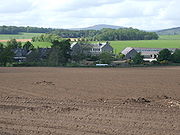
Dunecht
Encyclopedia

Linear village
In geography, a linear village, or linear settlement, is a small to medium-sized settlement that is formed around a transport route, such as a road, river, or canal. Wraysbury, a village in Berkshire, is one of the longest villages in England....
on the A944 road
A944 road
The A944 road connects Aberdeen with Strathdon in north-east Scotland.It originates at the Lang Stracht in the city, which is a re-routing as, until 1999, the road left Aberdeen by way of Queens Road in the City Centre. However this route could not cope with the traffic. The road then passes...
in north-east Aberdeenshire
Aberdeenshire
Aberdeenshire is one of the 32 unitary council areas in Scotland and a lieutenancy area.The present day Aberdeenshire council area does not include the City of Aberdeen, now a separate council area, from which its name derives. Together, the modern council area and the city formed historic...
in Scotland
Scotland
Scotland is a country that is part of the United Kingdom. Occupying the northern third of the island of Great Britain, it shares a border with England to the south and is bounded by the North Sea to the east, the Atlantic Ocean to the north and west, and the North Channel and Irish Sea to the...
. It is not to be confused with Echt
Echt, Aberdeenshire
Echt is an Aberdeenshire crossroads village in northeast Scotland with a population of approximately 300 people. Echt has a number of prehistoric remains, including the so called Barmekin of Echt which is on a hill to the northwest...
.
Dunecht is located 12 miles (19.5km) west of the city of Aberdeen
Aberdeen
Aberdeen is Scotland's third most populous city, one of Scotland's 32 local government council areas and the United Kingdom's 25th most populous city, with an official population estimate of ....
and is situated by the confluence of the Kinnernie and Bervie burns.
Formerly known as Waterton, it was renamed to Dunecht in the 1820s when the Crawford family built Dunecht House. The estate achieved a certain measure of notoriety in 1881 due to theft of the remains of the Alexander Lindsay, 25th Earl of Crawford
Alexander Lindsay, 25th Earl of Crawford
Alexander William Crawford Lindsay, 25th Earl of Crawford, 8th Earl of Balcarres , was a Scottish peer, art historian and collector. He was also known as Lord Lindsay....
.
It is now owned by Viscount Cowdray
Viscount Cowdray
Viscount Cowdray, of Cowdray in the County of West Sussex, is a title in the Peerage of the United Kingdom. It was created in 1917 for the industrialist Weetman Pearson, 1st Baron Cowdray, head of the Pearson conglomerate...
. Dunecht House is to the south of the village and was once famed for its observatory. Corsindae House is five miles west of here, and is in the Scottish baronial style; built between the 1450s and 1600s.
Amenities in the village include a school, a pub (Jaffs), and a garage-cum-shop.

